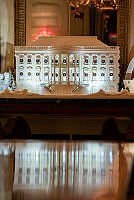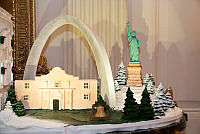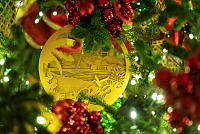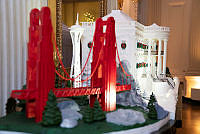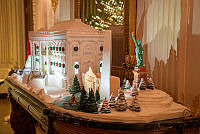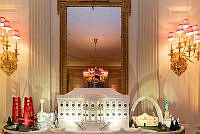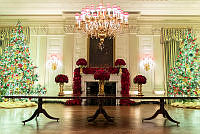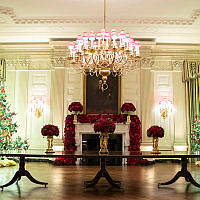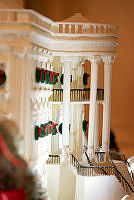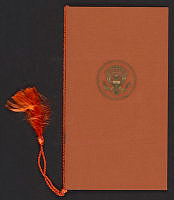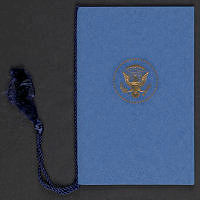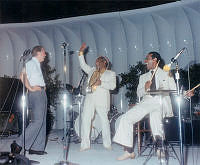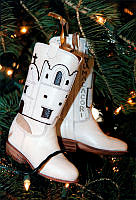Rubenstein Center Scholarship
Capturing History
The Legacy of White House Photographers
Gallery
-

This is a photograph of the famous Louis Comfort Tiffany Screen in the White House Entrance Hall by Frances Benjamin Johnston.
Library of Congress -

This is a photograph of Benjamin Harrison McKee, affectionately nicknamed "Baby McKee" by the press, holding the reigns of "His Whiskers," a goat presented to him by his grandfather President Benjamin Harrison. Also pictured from left to right are his uncle, Russell Harrison, son of the president, Russell's daughter Marthena Harrison, the dog Jack, and sister Mary Lodge McKee.
Library of Congress -

This portrait photograph by Frances Benjamin Johnston shows Alice Roosevelt, daughter of President Theodore Roosevelt, in the White House conservatory. The conservatories were removed in 1902 to build the West Wing.
Library of Congress -

This photograph by National Photo Company shows President Woodrow Wilson's sheep grazing on the South Lawn of the White House. Instead of using groundskeepers to cut the grass, the sheep grazed on the White House lawns. The flock grew to 48 at its peak. The wool sheared from the sheep was sold at auction to raise money for the Red Cross.
Library of Congress -

This photograph by Abbie Rowe of the National Park Service shows the gutted East Room during the Truman renovation of the White House from 1948-1952.
Abbie Rowe, National Park Service -

In this photograph by Abbie Rowe, President Dwight D. Eisenhower, First Lady Mamie Eisenhower, Queen Elizabeth II of Great Britain, and Prince Philip, Duke of Edinburgh, pose at the bottom of the Grand Staircase before a State Dinner on October 17, 1957.
National Archives and Records Administration -

President John F. Kennedy and his son, John F. Kennedy, Jr., play with a toy horse outside the Oval Office along the West Colonnade. This picture was taken by photographer Cecil Stoughton.
John F. Kennedy Presidential Library and Museum/NARA -

This black-and-white photograph by Cecil Stoughton shows Lyndon Johnson taking the oath of office aboard Air Force One in Dallas, Texas, shortly after the assassination of President John F. Kennedy. Lady Bird Johnson stands to Johnson’s right, while First Lady Jacqueline Kennedy looks on from his left.
Lyndon B. Johnson Presidential Library and Museum/NARA
The first known image of the White House was a daguerreotype taken in 1846, during the administration of President James K. Polk. This image, taken by John Plumbe, Jr. started a long tradition of photography surrounding the White House as a building and an institution.1 Since that first image, photographs have offered viewers a glimpse into the world of the American presidents, showcasing the interiors of the White House while illuminating the lives of those that worked and resided there. In today’s visual world, photographs are an important element of White House history as they allow us to capture and document specific moments in time, such as the flock of sheep that President Woodrow Wilson kept on the South Lawn during World War I; the addition of the Truman Balcony on the south side of the White House; and the decorations for Alice Roosevelt’s wedding in the East Room in 1906.
White House photographers have always worked to capture an intimate look at life in the Executive Mansion, whether it is through portraits or candid moments in the White House. Press access to the president varies by administration but White House photographers have witnessed private, secret, and contextual moments that have become vital pieces of the historical record. Those documenting the White House are visual historians, creating chronicles of the presidency in the form of images of America’s leaders in public and private. Although the position of Official White House Photographer has only been around since 1961, the photography of Frances Benjamin Johnston (1864-1962) and Abbie Rowe (1905-1967) continues to be significant assets to presidential administrations, historians, and the general public.2
The first photograph of a president in office was taken of William Henry Harrison on March 4, 1841, when the President Harrison posed for a daguerreotype portrait on Inauguration Day.3 The Met in New York City has the only known copy of this portrait. It became important to document presidents (both current and previous) with this new technology. Capturing presidents and former presidents was important for historical preservation and commercial gain. Citizens enjoyed seeing their leaders through this new medium, as it visually connected them to the figure in question. Photographers capitalized on the public’s fascination with the presidents, but soon enough this technology became an instrument of the presidency itself. While the public purchased these presidential portraits, it wasn’t until Abraham Lincoln that photography was used as an intentional way to connect with the public. In Lincoln’s 1860 presidential campaign, Lincoln distributed buttons that included a photo of him and Maine Senator Hannibal Hamlin. Lincoln was photographed nearly 130 times during his time in office, which gave a face to the Union war effort while also giving us a deeper look into his presidency.

A self portrait of Frances Benjamin Johnston. From the late 1880s to the 1910s, Johnston captured images of the White House that documented the lifestyles of the first families, workers, and visitors as well as its eclectic furniture and décor.
Library of CongressPresidential photography in publications and circulations was scarce until photography as a medium became more readily available and commercially viable. In the late nineteenth century, cameras became smaller, flash bulbs became efficient, and publishers developed technology to print photographs faster, which accelerated photography’s rise.4 Nearly four decades after the first image of the White House was taken, these innovations helped Frances Benjamin Johnston become one of the most successful female photographers in the field.5 She was an early proponent of the “Celebrity Portrait”— photographing people who the public wanted to see. When you conjure up an image of Mark Twain, Susan B. Anthony, or Theodore Roosevelt, you are most likely imagining one of her portraits.6 Johnston's documentary work was extensive and included a series of photographs commissioned by Booker T. Washington for the Hampton Institute in 1899 and the Tuskegee Institute in 1906. From the late 1880s to the 1910s, Johnston captured images of the White House that documented the lifestyles of the first families, workers, and visitors as well as its eclectic furniture and décor.7
While many are familiar with Johnston's photographs, most know little about the woman who made them. She was given her first camera by George Eastman, inventor of the Eastman Kodak cameras8 and was formally trained in photography from Thomas Smillie, the first photographer at the United States Museum, today known as The Smithsonian. In 1894, she opened her own studio, on V Street between 13th and 14th Streets in Washington D.C. She was the only female photographer in the city at the time.9 Johnston was well connected and often commissioned to do portrait work, capturing the elite and members of the upper class, such as Alice Roosevelt's wedding portrait. She was often at the White House or photographing related momentous events. She photographed Admiral George Dewey on the deck of the USS Olympia,10 the Roosevelt children playing with their pet pony Algonquin at the White House,11 and the Harrison grandchildren on the White House lawn.12 Johnston notably also took the last known photograph of President William McKinley, at the Pan-American Exposition of 1901, one day before his assassination.13 While Johnston’s portraits are recognizable, she also documented the interior and exterior of the White House, giving us photographs of the Tiffany Screen in the Entrance Hall, along with the gardens and conservatory on the White House Grounds. Johnston had access and photographed five first families: the Harrisons, the Clevelands, the McKinleys, the Roosevelts, and the Tafts.

This image shows the National Park Service photographer Abbie Rowe. Beginning in 1941, NPS assigned Abbie Rowe to cover the White House.
National Archives and Records AdministrationWhile Frances’ work gives us snapshots of these presidents and their lives, this work was not performed in any formal capacity by the U.S. Government. The responsibility of photographing the President of the United States in any formal capacity initially fell under the auspice of the National Park Service (NPS), which was tasked with capturing public photo opportunities.14 With the start of World War II, President Franklin Delano Roosevelt requested a photographer solely responsible for covering the president. Beginning in 1941, NPS assigned Abbie Rowe to this position, particularly to cover events that occurred away from the White House. Gradually, Rowe’s duties were expanded to include the documentation of events that took place within the White House itself. By the Harry S. Truman administration, he was called upon to document the president at many official ceremonies, and his work continued through the Dwight Eisenhower, John F. Kennedy, and Lyndon Johnson administrations.15 Rowe can be seen as a precursor to the Chief Official White House Photographer role we see today, but it was President John F. Kennedy who appointed the first Official White House Photographer Cecil Stoughton.16 Stoughton was given considerable access to the Kennedy family and helped expand the public’s view of Kennedy’s presidency. The pictures were pivotal in projecting President Kennedy as a youthful, relatable, and vigorous leader. Stoughton traveled everywhere with the president, including his tragic trip to Dallas, Texas in November 1963. In fact, he snapped the only pictures of Vice President Lyndon B. Johnson being sworn in as president, an image that still resonates in the minds of many Americans.17
Photographs have the ability to transcend time, capturing greater historical context and detail that other sources may omit. The work of Frances B. Johnston, Abbie Rowe, Cecil Stoughton, and the numerous other White House photographers have created an invaluable archive for the American public. These photos shape our view of the past, and also allow us to reflect on our future and the history happening in the photos we take now.





